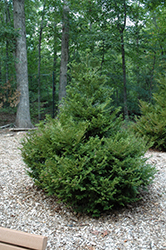Height: 30 feet
Spread: 15 feet
Sunlight:
![]()
![]()
Hardiness Zone: 6a
Description:
A close relative to the North American white cedar (arborvitae), with a similar appearance; tall, upright pyramidal habit of growth, evergreen foliage is dark and dense; does well in shade but needs shelter and a moist environment
Ornamental Features
Hiba Arborvitae is primarily valued in the landscape for its distinctively pyramidal habit of growth. It has dark green evergreen foliage. The scale-like sprays of foliage remain dark green throughout the winter.
Landscape Attributes
Hiba Arborvitae is a dense evergreen tree with a strong central leader and a distinctive and refined pyramidal form. Its relatively fine texture sets it apart from other landscape plants with less refined foliage.
This is a relatively low maintenance tree. When pruning is necessary, it is recommended to only trim back the new growth of the current season, other than to remove any dieback. It has no significant negative characteristics.
Hiba Arborvitae is recommended for the following landscape applications;
- Accent
- Vertical Accent
- Hedges/Screening
Planting & Growing
Hiba Arborvitae will grow to be about 30 feet tall at maturity, with a spread of 15 feet. It has a low canopy with a typical clearance of 2 feet from the ground, and should not be planted underneath power lines. It grows at a slow rate, and under ideal conditions can be expected to live for 80 years or more.
This tree does best in full sun to partial shade. It requires an evenly moist well-drained soil for optimal growth. It is particular about its soil conditions, with a strong preference for rich, acidic soils. It is somewhat tolerant of urban pollution, and will benefit from being planted in a relatively sheltered location. Consider applying a thick mulch around the root zone in winter to protect it in exposed locations or colder microclimates. This species is not originally from North America.
Disclaimer - This resource is provided for informational purposes only and does NOT reflect current availability. Inventory varies seasonally, so we cannot guarantee that every plant will be in stock at all times - please contact your favourite GardenWorks location directly for current availability. It does not include our entire inventory of plants, so be sure to visit GardenWorks to see varieties that may not be represented on this list.


